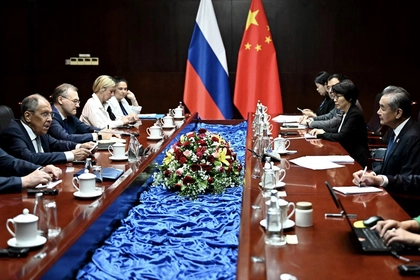Beijing launched an unannounced military exercise around Taiwan on Thursday as a show of force after Taipei’s presidential inauguration on Monday and vowed the blood of Taiwan’s “independence forces” would flow.
The drills, which covered outlying islands near Taiwan on a scale unseen in Beijing’s recent military exercises, come after Lai Ching-te was sworn in as Taiwan’s new president on Monday and made an inauguration speech that China denounced as a “confession of independence.”
JOIN US ON TELEGRAM
Follow our coverage of the war on the @Kyivpost_official.
Beijing’s foreign ministry spokesperson Wang Wenbin also delivered a stern warning, whose tone is not uncommon among their official statements on Taiwan during heightened tensions.
“Taiwan independence forces will be left with their heads broken and blood flowing after colliding against the great... trend of China achieving complete unification,” Wang told reporters, as reported by AFP.
Wang’s statement also echoed Chinese President Xi Jinping’s December statement to US President Joe Biden of his desire to reunify Taiwan by force if necessary.
President Lai said he would “stand on the front line” to defend Taiwan in a speech on Thursday afternoon, without directly referring to the ongoing drills.
“Faced with external challenges and threats, we will continue to defend the values of freedom and democracy, and safeguard peace and stability in the region,” he said.

Russia, China FMs Meet as ASEAN Talks Get Underway in Laos
US Army Lt. Gen. Stephen Sklenka, speaking in Canberra, described the exercises as “concerning” but not unexpected.
‘Joint Sword-2024A’
Thursday and Friday’s drills – codenamed “Joint Sword-2024A” – involve aircraft and ships surrounding the island to test their combat capabilities, China’s People's Liberation Army (PLA) said.
Taiwan responded by deploying air, ground, and naval forces, with the island’s defense ministry vowing to “defend freedom.”
The exercises, which began on Thursday morning, are taking place in the Taiwan Strait and north, south, and east of the island and extend to areas around the Kinmen, Matsu, Wuqiu and Dongyin islands under Taipei’s control and untouched by Beijing’s previous drills.
China’s military put out a series of posters touting what it called its “cross-strait lethality.” They featured missiles, combat aircraft, and naval vessels next to the blood-stained text.
“The weapon aimed at ‘Taiwan independence’ to kill ‘independence’ is already in place,” it declared.
The last time China announced similar military exercises around Taiwan was in August last year after Lai, then vice president, stopped over in the United States on a visit to Paraguay.
Those drills also tested the PLA’s ability “to seize control of air and sea spaces” and fight “in real combat conditions,” according to Beijing’s state media.
They followed April exercises that simulated the encirclement of the island, launched after Lai’s predecessor Tsai Ing-wen met then-US House Speaker Kevin McCarthy in California.
China also launched major military exercises in 2022 after Nancy Pelosi, then the Speaker of the US House of Representatives, visited Taiwan.
Heightening tensions on the Taiwan Strait
Since the Chinese civil war ended in 1949, both Beijing and Taipei have laid claims to each other’s sovereignty in their constitutions, though Lai, in his Monday inaugural speech, said “neither belongs to each other” and focused on protecting Taiwan’s sovereignty. He also called on other political parties “to not sacrifice sovereignty over the regime.”
Lai also called on Beijing to “stop attacking Taiwan with words and intimidating it militarily,” and he said both should work together to maintain regional stability and avoid war.
China has stepped up pressure on the island of 23 million people, periodically stoking worries about a potential invasion.
A Chinese military expert told CCTV that the drills were partly aimed at rehearsing an economic blockade of the island.
Zhang Chi, a professor at Beijing’s China National Defense University, said the drills aimed to “strangle” Taiwan’s critical Kaohsiung port to “severely impact” its foreign trade.
They would cut off “Taiwan's lifeline of energy imports” as well as “block the support lines that some US allies provide to “Taiwan independence forces,” he added.
World powers are keen to see as much stability as possible between China and Taiwan, not least because of the vital role the island plays in the global economy.
The Taiwan Strait is one of the world’s most important maritime trade arteries, and the island itself is a major tech manufacturer, particularly of vital semiconductors – the tiny chips used in everything from smartphones to missile systems.
The United States switched its diplomatic recognition from Taiwan to China in 1979 but remains the island’s most important ally and supplier of military hardware.
US President Biden has said he does not support Taiwan’s independence but also that he would back sending forces to defend the island. The official US position on intervention is one of ambiguity.
The United States did not give an immediate official response to the drills
You can also highlight the text and press Ctrl + Enter






